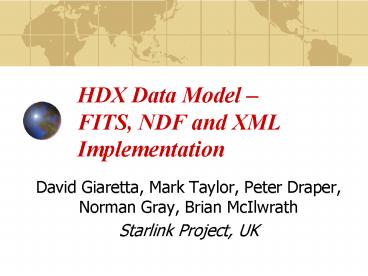HDX Data Model FITS, NDF and XML Implementation - PowerPoint PPT Presentation
1 / 19
Title:
HDX Data Model FITS, NDF and XML Implementation
Description:
FITS, NDF and XML Implementation. David Giaretta, Mark Taylor, Peter Draper, Norman Gray, Brian McIlwrath. Starlink Project, UK ... – PowerPoint PPT presentation
Number of Views:125
Avg rating:3.0/5.0
Title: HDX Data Model FITS, NDF and XML Implementation
1
HDX Data Model FITS, NDF and XML Implementation
- David Giaretta, Mark Taylor, Peter Draper, Norman
Gray, Brian McIlwrath - Starlink Project, UK
2
Outline
- Progress report on structure approach to data
- Bringing together existing Starlink data
structure (HDS) with FITS and XML - Part of work to make Starlink software support
the Virtual Observatory
3
Possible Requirements
- Flexible and extensible
- Capable of storing hierarchical data
- Supplement FITS and VOTable
- Strong astronomical data model
- Convenient for local access
- Usable on a wide range of platforms
- Standard enough to be used widely
- Amenable to remote access
- Able to be indexed/interrogated in sophisticated
ways
4
Example
5
VO data handling
- VO applications might be expected to deal with
- Remote data
- Need to add metadata e.g. additional
calibrations, refined astrometric data - Large numbers of interrelated files organised
into various collections - Any single file may be part of several
collections - New links may need to be created by users between
distributed files - Distributed/ parallel processing
- Automated processing may be needed e.g. dealing
with large numbers of files
6
Complex Relationships possible problems
- Applications could create increasingly complex
aggregations of data, to express increasingly
complex interrelationships - How are the relationship between the various
components defined? - How can different applications exchange
information effectively? - How can automated processing be facilitated?
7
Data Model proposal
8
Structured Object
- Need Structured Object in addition to Data
Objects - to separate the Structure from the Data
- avoid overcomplicating e.g. FITS
- allow use of distributed data
- Easily extensible to allow additional metadata
e.g. relationships - Need something moderately standardised because
- applications from many sources must have some
rules about what to do with things they do not
understand - Need to be able to validate data even non-XML
- Also need some standard components e.g.
- NDX (see later)
- VOTable
9
Structured Object HDX
- Flexible data model based on many years
experience with HDS using local data - Aim to support distributed processing and data
holding - Uses URIs to point to data
- Low (or even zero) overhead e.g. bare FITS files
OK - Can be serialised as XML
- Platform independent
- Format agnostic
- Natural data holding formats are XML and FITS
10
HDX
- HDX is a particular, simple, StructureObject
- An HDX is a W3C DOM which has a top-level element
lthdxgt, and which is valid. - valid if each of the document element's children
is - either unknown to the HDX system or,
- if known, is validated by its declared validator
(part of its registration) - the software implements the DOM API
11
Data access layer
- The abstract data model has been implemented in a
Java data-access library. - The support for the HDX system is distinct from
the support for the various HDX types which are
defined. - It is easy to extend the system to support new
types - It is easy to extend the system to support new
data storage resources, such as new file formats
or a database serving an archive. - These extensions can be implemented in very
efficient ways.
12
HDX UML from software
13
NDX
- NDX represents an N-dimensional chunk of
astronomical data and contains - Image pixel array (mandatory component)
- Variance pixel array
- Generalisable as error estimate systematic and
random - Quality pixel array
- Bad bit mask
- WCS information
- History information
- Title
- Units
- User-defined extensions (stored as XML)
- ...e.g. statistical values, thumbnails etc
probably calculated lazily - .
14
NDX operations
- Simple operations e.g. ndx1.add(ndx2) takes care
of variance, quality, WCS etc (where these
components are present) - Access is available to individual arrays
(NDArrays) is possible for more complex
algorithms
15
More details NDX/NDArray
- The philosophy and design goals behind
NDArray/NDX are - Very large arrays can be processed.
- Arrays of unlimited size can be processed in
limited memory. - Bad value processing is comprehensive and
transparent. - Array access is direct and transparent between
different formats. - Resource naming is location transparent.
- Deferred processing.
- Extensibility.
- Type independence where possible.
16
NDX UML
17
Treeview native view
18
View as HDX/NDX
19
Summary
- Work in progress
- There is a Java implementation see the Starlink
demo - Will be changed to support developing VO
standards - Extensible
- Supplements FITS and VOTable does not aim to
replace them































